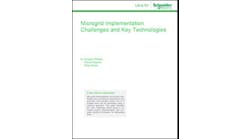An issue puzzling the power industry – how to pay for utility microgrids – is being taken up in a rate case now underway before the Arizona Corporation Commission.
Arizona Public Service (APS), the state’s largest utility, seeks to recover costs for two microgrids, a 63-MW data center microgrid and a 25-MW military microgrid. The utility made the request as part of a larger rate case (E-01345A-16-0036).
The microgrids are “necessary and in the public interest because they provide a platform to integrate increasing levels of renewable energy resources,” the utility said in its rate petition.
The case is the latest in a handful of tests of regulatory willingness by state commissions to let utilities recover microgrid costs in rates.
For the data center, APS is sharing costs with the host, Aligned Data Centers, a subsidiary of Aligned Energy. Each will pay for the portion of the microgrid that benefits them, according to APS testimony in the rate case.
The utility is requesting recovery of $5.6 million, which it says represents the portion of the project that serves all ratepayers – not just the data center.
The data center microgrid will run on small reciprocating engines, diesel generators that can start up and be at full power in about 20 seconds. The project also includes a new 69-kV enhanced-capability substation, located at Union Hills Drive and I-17 in Phoenix.
Operated by APS, the microgrid will provide not only back-up power to the data center but also capacity for the central grid. The microgrid’s gensets can quickly inject energy onto the grid, an asset when swift changes occur in renewable supply – such as when the wind suddenly stops blowing or a cloud covers the sun.
An APS spokeswoman said that the first phase — 12.5 MW — is about 80 percent complete and is expected to be finished by year’s end.
Cost-sharing, everybody wins
The cost-sharing arrangement for the data center microgrid creates an “everybody wins” scenario, according to Scott Bordenkircher, APS director of technology innovation.
“When APS is able to share in the costs of new generation with a site host, everybody wins,” he said in written testimony. “The larger APS customer community wins because this structure helps APS realize new peaking capacity via very cost-effective means which helps keep rates low, the State of Arizona benefits from a program with the ability to attract new economic development, and the host wins by being able to install on-site backup generation more cost-effectively than on a standalone basis.”
The second utility microgrid is a $21.6 million military project. It will provide back-up generation for the Marine Corps Air Station Yuma during power outages. It also will act as a supplemental power source for the rest of the community.
APS seeks full cost recovery of the military project, which will supply peaking capacity and frequency response reserves. The microgrid offers these services at a cost-savings compared with other market options, according to APS.
APS chose EPA Tier-4 diesel generators for the microgrids, rather than natural gas, because they offer quicker response time. The gensets also can be programmed to switch on automatically to ensure reliable power and frequency support, which helps to counteract larger system blackouts, the utility said.
Download our free report, “Reciprocating Engine Generators and Microgrids: The Last Defense Against a Power Outage.”
The microgrids are part of a larger $239 million capital investment that the utility plans to make in renewable energy and technology innovation. The commission expects to issue a decision on the APS rate request in June.
Utility microgrids in other states
Elsewhere the issue of how to pay for utility microgrids is being considered in Pennsylvania, where PECO Energy seeks to build two integrated community microgrids for a high density neighborhood with an 8.6 MW load.
In Maryland, state regulators in July rejected a request by Baltimore Gas & Electric to recover costs for two public purpose microgrids that the utility planned to build. The rejection came, in part, because the commission found it unfair to ask all utility customers to pay for what might benefit only a few.
In Washington, Avista plans to seek cost recovery for a Smart Cities microgrid now in planning.
The rate requests are complicated by the unusual nature of microgrids. They directly serve only a small number of utility customers when they island and supply back-up generation during power outages. Yet, the rest of the time, they can serve as grid resources, offering capacity, frequency, demand response and other services that benefit all ratepayers. Their ability to do so depends on their internal sophistication as well as marketplace rules where they are located.
How to pay for utility microgrids? Share your thoughts on our Linkedin Group, Microgrid Knowledge.






